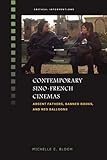Contemporary Sino-French Cinemas : Absent Fathers, Banned Books, and Red Balloons / Michelle E. Bloom; ed. by Sheldon Hsiao-peng Lu.
Material type: TextSeries: Critical InterventionsPublisher: Honolulu : University of Hawaii Press, [2016]Copyright date: ©2016Description: 1 online resource (296 p.) : 35 black & white illustrationsContent type:
TextSeries: Critical InterventionsPublisher: Honolulu : University of Hawaii Press, [2016]Copyright date: ©2016Description: 1 online resource (296 p.) : 35 black & white illustrationsContent type: - 9780824851583
- 9780824857455
- 791.430951 23
- online - DeGruyter
- Issued also in print.
| Item type | Current library | Call number | URL | Status | Notes | Barcode | |
|---|---|---|---|---|---|---|---|
 eBook
eBook
|
Biblioteca "Angelicum" Pont. Univ. S.Tommaso d'Aquino Nuvola online | online - DeGruyter (Browse shelf(Opens below)) | Online access | Not for loan (Accesso limitato) | Accesso per gli utenti autorizzati / Access for authorized users | (dgr)9780824857455 |
Frontmatter -- Contents -- Acknowledgments -- Introduction to Contemporary Sino-French Cinemas -- PART ONE. Franco-Taiwanese Cinema -- 1. The Sino-French as Métissage -- 2. Intertextuality as Métissage in Tsai Ming-liang's Sino-French Films -- 3. Hou Hsiao-hsien's Flight of the Red Balloon as a Sino-French Makeover -- PART TWO. Franco-Chinese Cinema -- 4. Translations of Dai Sijie's Balzac and the Little Chinese Seamstress -- 5. Imitating Frenchness in Emily Tang Xiaobai's Conjugation and Jia Zhangke's The World -- Conclusions Mixing It Up -- Notes -- Filmography -- Bibliography -- Index -- About the Author
restricted access online access with authorization star
http://purl.org/coar/access_right/c_16ec
Transnational cinemas are eclipsing national cinemas in the contemporary world, and Sino-French films exemplify this phenomenon through the cinematic coupling of the Sinophone and the Francophone, linking France not just with the Chinese mainland but also with the rest of the Chinese-speaking world. Sinophone directors most often reach out to French cinema by referencing and adapting it. They set their films in Paris and metropolitan France, cast French actors, and sometimes use French dialogue, even when the directors themselves don't understand it. They tend to view France as mysterious, sexy, and sophisticated, just as the French see China and Taiwan as exotic.As Michelle E. Bloom makes clear, many films move past a simplistic opposition between East and West and beyond Orientalist and Occidentalist cross-cultural interplay. Bloom focuses on films that have appeared since 2000 such as Tsai Ming-liang's What Time Is It There? , Hou Hsiao-hsien's Flight of the Red Balloon, and Dai Sijie's Balzac and the Little Chinese Seamstress. She views the work of these well-known directors through a Sino-French optic, applying the tropes of métissage (or biraciality), intertextuality, adaptation and remake, translation, and imitation to shed new light on their work. She also calls attention to important, lesser studied films: Taiwanese director Cheng Yu-chieh's Yang Yang, which depicts the up-and-coming Taiwanese star Sandrine Pinna as a mixed race beauty; and Emily Tang Xiaobai's debut film Conjugation, which contrasts Paris and post-Tiananmen Square Beijing, the one an incarnation of liberty, the other a place of entrapment. Bloom's insightful analysis also probes what such films reveal about their Taiwanese and Chinese creators.Scholars have long studied Sino-French literature, but this inaugural full-length work on Sino-French cinema maps uncharted territory, offering a paradigm for understanding other cross-cultural interminglings and tools to study transnational cinema and world cinema. The Sino-French, rich and multifaceted, linguistically, culturally, and ethnically, constitutes an important part of film studies, Francophone studies, Sinophone studies and myriad other fields. This is a must-read for students, scholars, and lovers of film.
Issued also in print.
Mode of access: Internet via World Wide Web.
In English.
Description based on online resource; title from PDF title page (publisher's Web site, viewed 29. Jul 2021)


